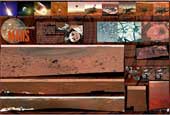
 |
|
|
|
For 12 years Carnarvon, a desert trading post on the remote north-west coast of Australia, provided NASA’s largest tracking station outside the US mainland. Established in 1963, it provided an essential stepping-stone enabling the Apollo astronauts to land on the Moon. Every spacecraft launched from Cape Canaveral passed close to Carnarvon on its first orbit, and James Webb, head of NASA, said its ability to check their flight direction, altitude and velocity was essential to secure the astronauts’ safety. By 1975, however, a series of tracking and data relay satellites in geosynchronous orbit made the ground stations redundant. Carnarvon’s masts and dishes were demolished, so that it is once more nothing but a small trading and fishing port. The famous film, The Dish, told a rather embellished story of the part Australia’s eastern tracking stations played in providing the first TV pictures of Neil Armstrong’s first steps on the moon. This rather patchy book tells the more technical and essential story of how Australia’s six tracking and relay stations enabled NASA to maintain contact with Apollo when, from their viewpoint, the craft were hidden on the far side of the Earth. Carnarvon’s scientists played a major part in ensuring the safe return of the Apollo 13 crew in their crippled spacecraft. As re-entry began they warned NASA that two back-up gyros that had not been turned off were starting a power overload that could have finally destroyed the command module. They also monitored the jettisoned Lunar Module to ensure it plunged safely into deep water in the Pacific, since it contained a potentially lethal nuclear power pack. The authors also describe how, four years after Carnarvon closed, falling debris from the 90-tonne Skylab space station was scattered across Australia. A youth of 17 collected some from his back garden, caught the first flight to California, and claimed a $10,000 prize for the first debris to be delivered. Reginald Turnill |
|
|
|
2009 Yearbook This 132-page special edition features the ultimate observing guide for 2009, a review of all the biggest news stories of 2008, in depth articles covering all aspects of astronomy and space missions for 2009, previews of International Year of Astronomy events and much, much more. This 132-page special edition features the ultimate observing guide for 2009, a review of all the biggest news stories of 2008, in depth articles covering all aspects of astronomy and space missions for 2009, previews of International Year of Astronomy events and much, much more.Infinity Rising  This special publication features the photography of British astro-imager Nik Szymanek and covers a range of photographic methods from basic to advanced. Beautiful pictures of the night sky can be obtained with a simple camera and tripod before tackling more difficult projects, such as guided astrophotography through the telescope and CCD imaging. This special publication features the photography of British astro-imager Nik Szymanek and covers a range of photographic methods from basic to advanced. Beautiful pictures of the night sky can be obtained with a simple camera and tripod before tackling more difficult projects, such as guided astrophotography through the telescope and CCD imaging.Exploring Mars  Astronomy Now is pleased to announce the publication of Exploring Mars. The very best images of Mars taken by orbiting spacecraft and NASA's Spirit and Opportunity rovers fill up the 98 glossy pages of this special edition! Astronomy Now is pleased to announce the publication of Exploring Mars. The very best images of Mars taken by orbiting spacecraft and NASA's Spirit and Opportunity rovers fill up the 98 glossy pages of this special edition!Mars rover poster  This new poster features some of the best pictures from NASA's amazing Mars Exploration Rovers Spirit and Opportunity. This new poster features some of the best pictures from NASA's amazing Mars Exploration Rovers Spirit and Opportunity. |
||||||||||||||||||||||||